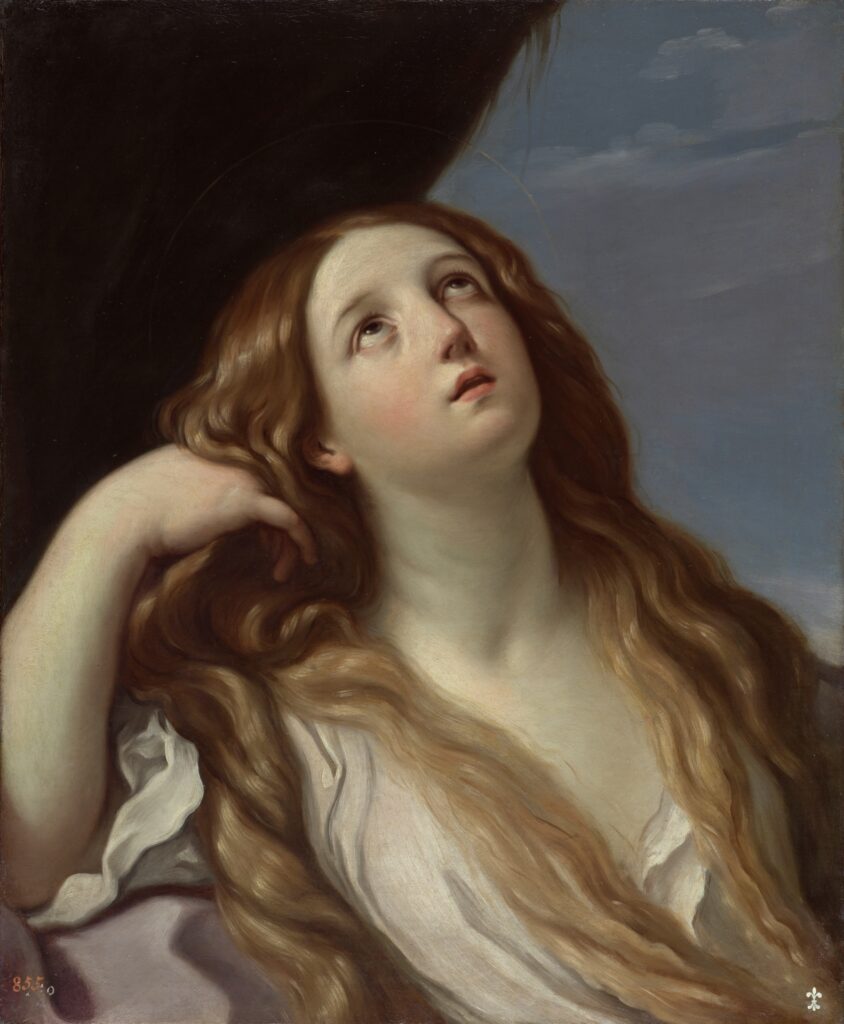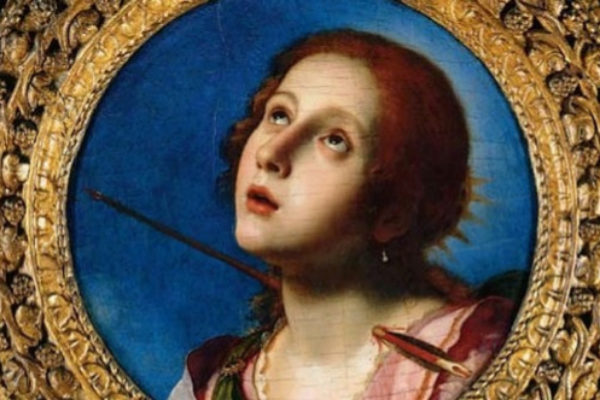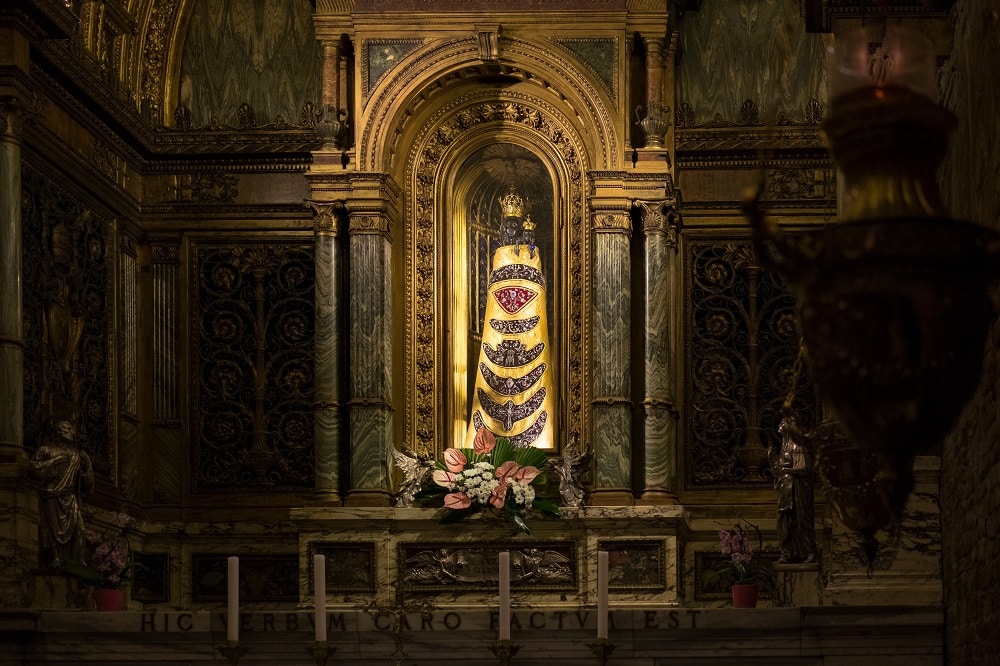Saint Mary Magdalene, July 22
Disciple of the Lord

From the Gospel according to Saint John
On the first day of the week, early in the morning, while it was still dark, Mary Magdalene came to the tomb of Jesus and saw that the stone had been removed from its place. She ran to Simon Peter and the other disciple, the one Jesus loved, and said to them, “They have taken the Lord from the tomb, and we don’t know where they have laid him.”
The Gospel narrates: “Mary stood outside the tomb weeping. While she wept, she looked up and saw two angels in white sitting, one at the head and one at the foot, where Jesus’ body had been lying. They said to her, “Woman, why are you weeping?” Mary replied, “Because they have taken away my Lord, and I do not know where they have laid him.”
When she said this, she turned around and saw Jesus standing there, but she did not recognize him. Jesus asked her, “Woman, why are you weeping? Whom are you looking for?” Supposing he was the keeper of the garden, she answered, “Lord, if you have taken him away, tell me where you have laid him, and I will go and get him.” Jesus said to her, “Mary!” She recognized him and said to him in Hebrew, “Rabboni” (that is, “Teacher”). Jesus said to her, “Do not hold me back, for I have not yet ascended to the Father. Go and tell my brothers, ‘I am going to my Father and your Father, to my God and your God.’” Mary Magdalene came and told the disciples that she had seen the Lord and that he had spoken these words to her” (Jn 20:11-18).
Mary Magdalene in Saint John Paul II
It was Saint John Paul II who devoted great attention not only to the importance of women in the mission of Christ and the Church, but also, and with special emphasis, to the particular role of Mary of Magdala as the first witness to see the Risen Lord and the first messenger to announce the Lord’s Resurrection to the Apostles (cf. Mulieris Dignitatem, no. 16). This special consideration continues in the Church today—as demonstrated by the current commitment to the new evangelization—which desires to welcome, without distinction, men and women of every race, people, language, and nation (cf. Rev 5: 9), to announce to them the good news of the Gospel of Jesus Christ, to accompany them on their earthly pilgrimage, and to offer them the wonders of God’s salvation. Saint Mary Magdalene is an example of a true and authentic evangelizer, that is, an evangelizer who proclaims the joyful central message of Easter (cf. Collect of July 22 and new preface).
Mary Magdalene in Pope Francis
The Holy Father Francis decided to establish the liturgical feast of Mary Magdalene in the context of the Jubilee of Mercy, to underline the significance of this woman who showed great love for Christ. It is true that Western ecclesial tradition, especially after Saint Gregory the Great, identified Mary of Magdala, the woman who poured perfume in the house of Simon the Pharisee, and the sister of Lazarus and Martha in the same person. This interpretation continued and influenced Western ecclesiastical authors, Christian art, and liturgical texts relating to the Saint.
Mary Magdalene, first witness of the Resurrection
Mary Magdalene was part of Jesus’ group of disciples, following him to the foot of the cross and, in the garden where the tomb was located, she was the first “testis divinae misericordiae,” as Saint Gregory recalls. The Gospel of John we have just read tells us that Mary Magdalene wept because she had not found the Lord’s body, and Jesus took pity on her, transforming her tears into Easter joy.
Thus, she has the honor of being the first witness of the Lord’s Resurrection, the first to see the empty tomb and confirm the truth of his Resurrection. Christ has special consideration and mercy toward this woman who shows her love for him, seeking him in the garden with anguish and suffering, with “lacrimas humilitatis,” as Saint Anselm says.
Furthermore, it is precisely in the Garden of Resurrection that the Lord says to Mary Magdalene: “Noli me tangere” (“Do not hold me back”). It is an invitation—addressed not only to her, but to the entire Church—to enter into an experience of faith that goes beyond all materialistic appropriation and all human understanding of the divine mystery. It has an ecclesial significance. Likewise, it is a good lesson for every disciple of Jesus: do not seek human security, but faith in the living and risen Christ.
Mary Magdalene, apostle of the apostles
Precisely because she was an eyewitness to the risen Christ, Mary Magdalene was also the first to bear witness to him before the apostles. She fulfilled the risen Lord’s command: “Go to my brothers and tell them…” Mary went and told the disciples: “I have seen the Lord,” and what he had said to her (Jn 20:17-18). In this way, she becomes a messenger who announces the good news of Christ’s resurrection; or, as Rabanus Maurus and Saint Thomas Aquinas said, “apostolorum apostola,” because she announces to the apostles what they, in turn, will announce to the whole world. The Angelic Doctor aptly uses this term, applying it to Mary Magdalene: she is a witness to the risen Christ and announces the message of the Lord’s resurrection, like the other apostles.
 (EN)
(EN)
 (ES)
(ES)
 (IT)
(IT)



